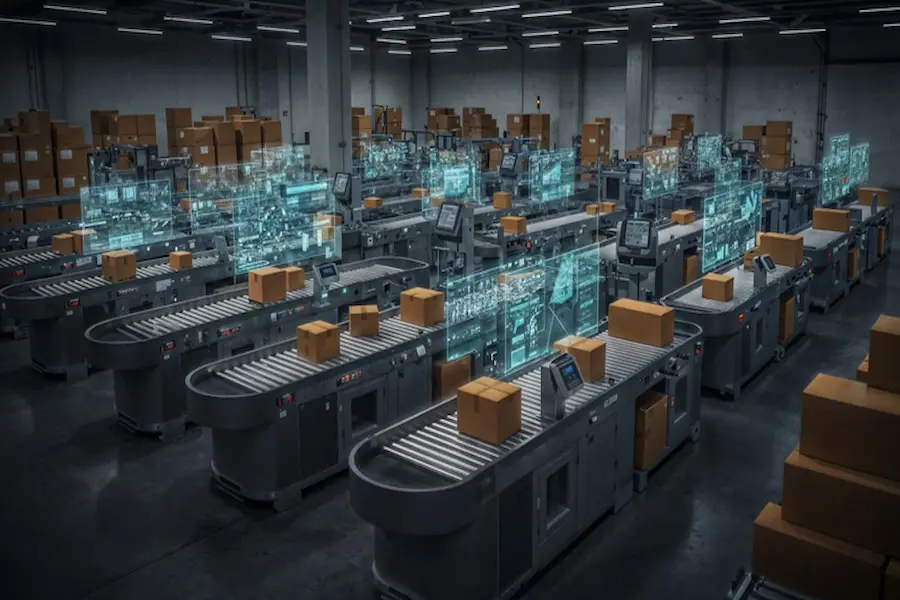Are you facing slow, error-prone warehouse operations that seem impossible to improve? You’re not alone. Many businesses face these challenges, but there’s a simple solution: warehouse automation. By integrating automated systems into your warehouse, you can speed up operations, reduce errors, and save both time and money. But how does this work, and what specific benefits can it bring to your business?
From my experience, automation isn’t just for large corporations it’s something businesses of all sizes can and should embrace to stay competitive. Automation can significantly transform your warehouse operations, helping you streamline processes, increase efficiency, and ultimately improve your bottom line. Let’s dive deeper into how automation can work for you.
1. Understanding Warehouse Automation: What Does It Really Mean?
Automation Warehouse uses technology to carry out tasks that were once performed manually. Automated systems, such as conveyor belts, robotic arms, automated storage and retrieval systems (ASRS), and sophisticated inventory management software, are central to this process. The goal is to improve speed, accuracy, and cost-effectiveness.
By incorporating automated systems, tasks like picking, packing, and shipping are streamlined. These systems operate continuously, making order fulfillment faster and more reliable, which reduces the chances of human error. As a result, processing times are cut down, and inventory management becomes more efficient.
In many cases, automated systems work in tandem. For example, conveyor systems can carry items to robotic arms, which then pick and pack them before moving to shipping. This seamless integration of systems is what makes warehouse automation such a powerful tool.
2. Speed and Efficiency: Why Automation Warehouse Is a Game-Changer
One of the immediate advantages of Automation Warehouse is the speed at which it operates. Automated systems, particularly robots, can pick and pack items far faster than a human could. Moreover, these systems work 24/7 without the need for breaks or downtime.
This doesn’t just speed up daily operations; it means your warehouse can handle more orders during peak seasons without adding extra staff. The ability to scale operations efficiently during busy times is a major benefit. During peak shopping periods like Black Friday, when order volumes surge, automated systems can manage increased demand seamlessly, reducing the risk of overwhelmed staff or delayed shipments.
I’ve seen firsthand how businesses adapt during busy seasons by automating repetitive tasks. This type of efficiency not only reduces stress but helps businesses meet customer demands without compromising quality.
3. Reducing Errors: How Automation Warehouse Improves Accuracy
Human errors in the warehouse can be costly, leading to wrong orders, misplaced inventory, and missed shipments. These mistakes result in dissatisfied customers and lost revenue. Fortunately, automation can significantly reduce errors by handling tasks with high precision.
For example, robotic arms and conveyor systems can sort and transport products with accuracy. Their ability to pick and place items precisely means that the correct product is always sent to the right customer. This reduces the chances of product returns and increases customer satisfaction, which has a direct positive impact on your bottom line.
Real-world examples, like companies in the retail sector, have successfully integrated robotic picking systems to maintain high accuracy during high-volume times like holiday sales.
4. Cutting Costs: How Automation Warehouse Saves Money
You might be wondering about the upfront cost of setting up Automation Warehouse. While the initial investment can be significant, the savings in the long run are clear. By automating repetitive processes, you can reduce labor costs, lower error rates, and increase throughput, all of which directly impact profitability.
For example, fewer workers are required to manage the picking and packing processes. Automation Warehouse systems also lead to fewer returns from incorrect shipments, reducing operational costs. Additionally, by providing real-time data on inventory levels, automation helps prevent excess stock, saving on storage costs and reducing waste.
I’ve seen businesses recoup their investment in automation far quicker than expected because of these long-term savings. These systems not only improve productivity but also streamline overall operations, making them more cost-effective in the long run.
5. Real-Time Data: How Automation Warehouse Improves Decision Making
A major benefit of warehouse automation is the access to real-time data. Automated systems provide detailed insights into inventory levels, order statuses, and system performance. This allows managers to make informed decisions quickly, ensuring that operations continue to run smoothly.
For example, if a product is running low, the system can alert managers to reorder before it runs out. This proactive decision-making helps prevent stockouts and ensures that customers’ needs are met without delay.
Real-time data also helps improve forecasting by providing a clearer picture of how inventory is performing. As you optimize stock levels, you can improve the accuracy of your future predictions, making your warehouse even more efficient.
6. Predictive Analytics: Anticipating Needs Before They Arise
Predictive analytics powered by advanced software tools forecasts trends in your warehouse operations, such as demand, shipping volumes, and inventory needs. With predictive tools, you can avoid stockouts or excess inventory, which can throw your supply chain off track.
For instance, during peak seasons, Automation Warehouse can predict a rise in demand for specific products and adjust inventory levels accordingly. This keeps operations smooth and ensures that customers get their orders on time, which in turn boosts satisfaction and brand loyalty.
Automation Warehouse ability to predict needs before they arise not only reduces stress during busy seasons but also allows for long-term operational adjustments that improve supply chain management.
7. Scalability: How Automation Can Grow with Your Business
As your business expands, so do your operational needs. Fortunately, automation systems are designed to scale with your business. Whether you’re increasing your product range or managing a larger order volume, automated systems adapt without requiring significant changes to the infrastructure.
Automation also makes it easier to replicate processes in new warehouses or regions. With systems in place, scaling doesn’t mean facing overwhelming logistical challenges. You can simply adjust the system to meet new demands without compromising operational efficiency.
8. Sustainability: How Automation Warehouse Supports Green Practices
Automation Warehouse isn’t just a win for your business; it’s also good for the environment. By optimizing energy use, minimizing waste, and reducing excess packaging, automation helps make your warehouse more sustainable.
Automated systems often use energy-efficient equipment, such as LED lighting and low-energy robots, which reduce energy consumption. Additionally, automation aids in recycling and better waste management, which lowers your overall carbon footprint.
Many companies that have embraced automation have found it’s an environmentally responsible move, as it helps conserve resources and manage waste more efficiently.
9. Industry Applications: How Different Sectors Benefit from Automation Warehouse
Warehouse automation benefits multiple sectors. In retail, automation allows for faster order fulfillment, especially during high-demand periods like Black Friday. For manufacturing, it improves precision in handling parts and reduces errors. In pharmaceuticals, automation ensures compliance with strict regulations, allowing products to be stored and distributed accurately.
10. Choosing the Right Automation Warehouse System for Your Warehouse
Selecting the right automation system is crucial. Every warehouse is different, and a one-size-fits-all solution doesn’t exist. Start by evaluating your current operations and identifying which tasks are time-consuming or prone to errors.
For warehouses handling small parts, automated storage and retrieval systems (ASRS) are ideal. For larger items, mobile robots (AGVs) are perfect. Understanding the specifics of your warehouse operations will help you select the right solution.
11. Key Automation Warehouse Tools You Should Know About
Here are some essential tools used in warehouse automation:
Mobile Robots (AGVs): Transport goods across the warehouse, reducing the need for forklifts and manual labor.
Conveyor Systems: Efficiently move items over long distances, speeding up sorting and packaging processes.
Robotic Picking Systems: Quickly and accurately pick items from shelves.
Automated Storage and Retrieval Systems (ASRS): Automatically store and retrieve goods, optimizing space.
12. How to Implement Automation in Your Warehouse
Implementing automation is a step-by-step process that requires careful planning. Start by evaluating your current processes and identifying which ones can benefit most from automation.
Work with vendors who can design systems tailored to your needs, and invest in training to ensure your staff can smoothly adopt these new tools.
13. Maintaining and Optimizing Your Automated Warehouse Systems
Once in place, regular maintenance is key to keeping systems running at peak efficiency. Routine checks and software updates help keep everything working smoothly.
Continuous monitoring lets you spot potential issues before they turn into bigger problems, preventing costly downtime.
14. Measuring the Performance of Your Automation System
Track key performance metrics, such as order fulfillment speed, error rates, and labor cost savings, to evaluate how well your system is performing.
Regular assessments ensure you’re maximizing the return on your investment and continuously improving your operations.
15. The Future of Warehouse Automation: What’s Next?
As technology evolves, so does warehouse automation. In the future, we’ll see even smarter systems powered by AI and machine learning. These technologies will help with real-time decision-making, improving inventory management and supply chain efficiency.
Staying ahead of these innovations will help keep your business at the forefront of efficiency and adaptability.
16. Ready to Automate Your Warehouse?
If you’re ready to take your warehouse operations to the next level, automation is the way to go. With benefits ranging from increased speed and accuracy to significant cost savings, the advantages are clear. By selecting the right tools and maintaining them properly, your warehouse will thrive in the digital age.
Conclusion: The Power of Automation Warehouse for Your Business
Automation Warehouse isn’t just a trend it’s a game-changer. It boosts operational efficiency, reduces costs, and improves accuracy. Automating tasks like inventory management, order fulfillment, and transportation streamlines processes and improves customer service.
Although the initial investment may seem high, the long-term rewards far outweigh the costs. Whether you want to increase speed, improve accuracy, or scale without additional labor costs, automation can transform your warehouse operations for the better.
So, as you consider integrating automation, think about the future you want for your business. With the right strategy, tools, and mindset, you can make automation work for you and stay ahead of the competition.
Read Also : Pro Automation: 8 Ways to Boost Efficiency and Save Time for Maximum Business Growth

